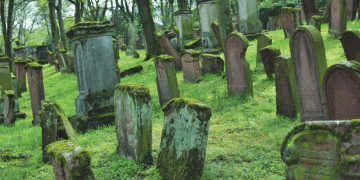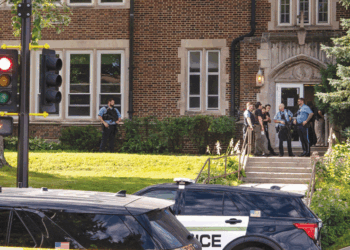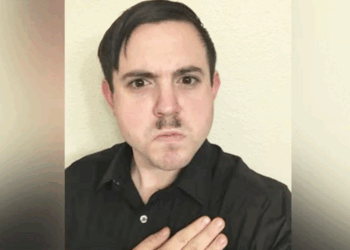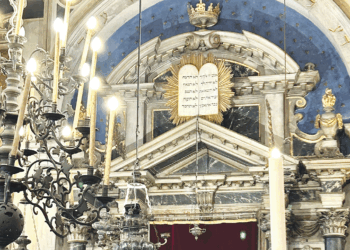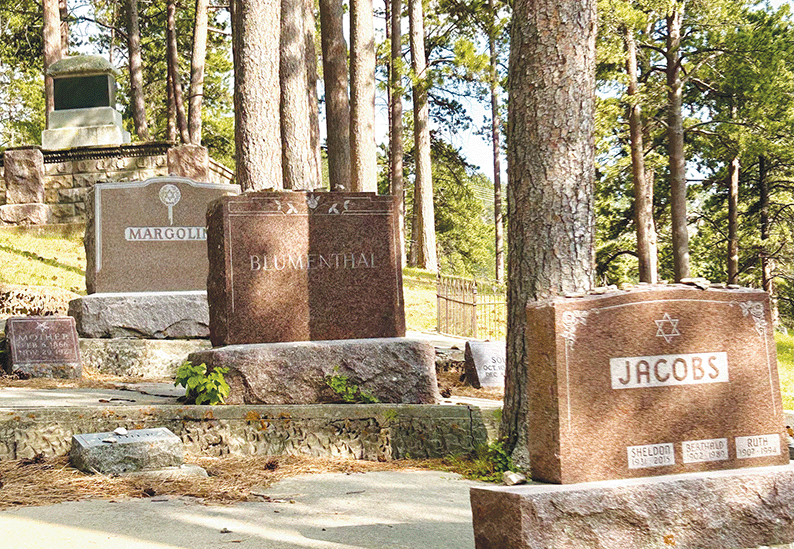
In early July, our family set off for the Badlands and Black Hills of South Dakota. This was our first family trip with our three sons, daughter-in-law and girlfriends, and the two little grandkids — the whole mishpacha (family). (Since my wife, Maj-Britt, is from Sweden, I’m Farfar, “father’s father” in Swedish, to our grandchildren). We were 10 in all, in three cars heading west.
My expat son, Max, and Silvia, his Italian girlfriend, flew in from Copenhagen for the vacation sojourn, which was a belated celebration of our 40th wedding anniversary in January. It was wonderful having our family together and seeing the sights.
Of course, we stopped at “The World’s Only Corn Palace,” in Mitchell, South Dakota. The Corn Palace, which dates to 1892 in its first version, was adorned with a prominent swastika decoration in 1907. The swastika was a Native design element, which was “intended to signify prosperity and good fortune,” according to an account on the South Dakota Public Broadcasting website. Actually, the swastika appeared for thousands of years in the iconography of various religions and peoples in far-flung lands. The swastika was a popular design motif in commercial advertising; the Girls’ Club of America called its magazine Swastika. When the Nazis appropriated the symbol — the Hakenkreuz, hooked cross — and then set Europe on fire in their campaign of conquest and mass murder, the swastika fell into disrepute.
Anyway, our family caravan had dinner at a Mexican restaurant in Chamberlain and spent our first night on the road in a hotel above the Missouri River. In my view, when you cross the Missouri, you’re in the American West.
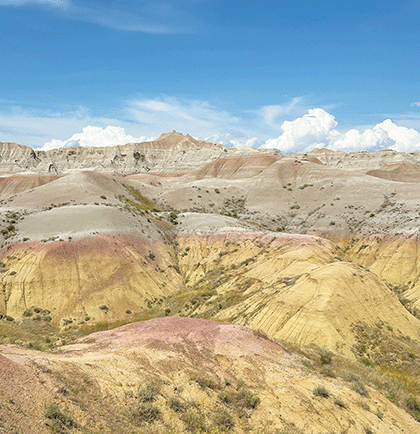
After enjoying the free hotel breakfast, our caravan set off for the Badlands. We traveled the Badlands loop, marveling at the varied and colorful rock formations. I’ve been through Badlands National Park many times but have never seen as much greenery throughout as was present in early July. We saw numerous flooded farm fields in Minnesota, and beneficial rains also made the Badlands bloom, the valleys and buttes. The Badlands, created by the deposition of rocks beginning about 75 million years ago, is usually a parched land.
After our tour of the Badlands, we headed back up to I-90 and stopped in Wall, home of Wall Drug. Opened in 1931, Wall Drug posted signs along the highways offering free ice water to travelers. It’s now a major tourist trap, with restaurants and gift shops full of chotchkes.
Driving west past Rapid City, we began our ascent into the Black Hills. Our vacation rental was a large house in the treetops, above the town of Lead, which was a gold mining center in the late 19th century. And nearby is the legendary town of Deadwood, which began as a mining camp serving the needs of prospectors panning local streams for flakes and nuggets of gold.
My eldest son, Jonas, brought along a book, The Cost of Free Land: Jews, Lakota, and an American Inheritance (Viking, 2023), by Rebecca Clarren. I read a bit of the book while on vacation, and then purchased a copy. The book combines two of my longtime journalistic pursuits: American Indian issues and the Jewish story.
Clarren, who lives with her family in Portland, Oregon, investigates the lives of her ancestors who fled violent persecution in the Pale of Settlement and landed in the American West. Their names will be familiar to many in the local Jewish community: Sinykins and Kozbergs.
Early in the book, Clarren meets with her great-aunt, Etta Fay (Kozberg) Orkin, in her St. Louis Park home, to look over old family photos and hear some family stories. Orkin is the granddaughter of Harry Sinykin, who was seriously injured in a pogrom in Odesa, Ukraine, barely escaping with his life. Sinykin “left Odesa, never to return,” according to the author. Harry’s brother Sam left the Old Land of Woe and settled in Sioux City, Iowa. He later brought over his brother Harry and other family members. The family eventually took advantage of the federal government’s free land program and moved out to the South Dakota prairie.
Clarren interweaves her family’s history with the epochal events affecting the original inhabitants of the Northern Great Plains, the Lakota (Oceti Sakowin). The 1868 Treaty of Fort Laramie between the U.S. government and the Great Sioux Nation established a vast tract of land for the Lakota (sometimes referred to as Teton Sioux): all of present-day South Dakota west of the Missouri River and parts of North Dakota, Nebraska and Wyoming. The U.S. government treated with the Lakota — there was an earlier Fort Laramie Treaty, in 1851 — because the Lakota, along with allied Cheyenne and Arapaho warriors, were attacking and burning U.S. forts in the West. The government formed the Indian Peace Commission to end hostilities and provide settlers with unfettered passage through Indian Country.
Like nearly all the hundreds of treaties that the U.S. negotiated with Indian tribes, the 1868 Fort Laramie Treaty was broken when George Armstrong Custer led an expedition into the Black Hills, in 1874, which led to the Black Hills Gold Rush. In 1876, the Great Sioux War broke out, leading eventually to the tragic massacre of Chief Spotted Tail’s band that had surrendered and was encamped along Wounded Knee Creek, in December 1890.
In The Cost of Free Land, Rebecca Clarren notes that the massacre of Lakota men, women and children at Wounded Knee was reported in the press of the day as a “critical military victory.” She quotes L. Frank Baum, author of The Wizard of Oz and editor of the Aberdeen Saturday Pioneer newspaper, who wrote an editorial six days after the Wounded Knee massacre: “Our only safety depends upon the total extirmination (sic) of the Indians. Having wronged them for centuries we had better, in order to protect our civilization, follow it up by one more wrong and wipe these untamed and untamable creatures from the face of the earth.” Baum’s views on the Lakota likely accorded with those of most European settlers in the territory at that time.
I’ve read that Baum modeled his fictional Emerald City on the Black Hills, where a tourist does not encounter many Native people today. (I talked this week with an Oglala Lakota lawyer from the Pine Ridge reservation. Regarding the lack of Lakota people in the Black Hills, he mentioned that his people “are made to feel unwelcome” there.)
Apart from its gruesome history, the Black Hills is a beautiful place. We traveled to Custer State Park, in the southern Black Hills, to see the buffalo herds; drove along the Needles Highway amid amazing stone formations and narrow tunnels carved out of the rocks; and traveled up north through idyllic Spearfish Canyon.
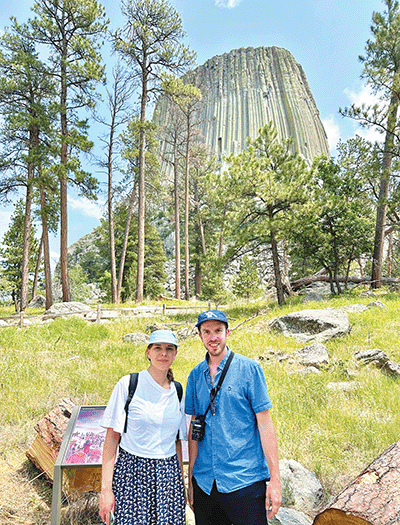
On a Thursday, I got my wish to see Devil’s Tower, again. I drove with Max and Silvia north out of the Black Hills and into Wyoming. We stopped at the general store in Aladdin, population 15, and I bought a souvenir T-shirt, as I had about 20 years earlier. The first T-shirt noted a somewhat smaller population and carried the line that Aladdin was “out in the boondocks.”
Driving west from Aladdin, Devil’s Tower came into view, rising dramatically above the plains. I had thought that Devil’s Tower was the core of an old volcano; but, current scientific thought describes it as a magma upthrust. The impressive formation of columns stands 1,267 feet above the Belle Fourche River; from the base to the summit, it measures 867 feet. The Native people call it the “Bear Lodge.”
In 90-degree heat, we went on a 1.3-mile walk around Devil’s Tower. There is a paved trail around Devil’s Tower National Monument. We returned to our car in the parking lot by the visitor center and headed to a nearby picnic area for sandwiches and beverage, as the Bear Lodge loomed above us.
My grandchildren enjoyed their sojourn in South Dakota, unaware of the tortured history and current benighted politics of the state. We visited parks and splash pads and enjoyed family dinners and the spectacular view of the Black Hills from the second-story deck of our vacation rental.
I’ve spent time over the past 40 years on the Pine Ridge and Rosebud reservations, and I know more about the history of the area than most of my compatriots. The depredations of the U.S. government against the Lakota reverberate to this day. Generally, the domestic Native nations are still fighting for their land and the preservation of their lifeways against the encroaching dominant society.
Rebecca Clarren concludes The Cost of Free Land with some suggestions on healing our shared history of trauma and loss. Her rabbi quotes Rabbi Nachman of Bratzlav: “If you believe breaking is possible, believe fixing is possible.”
Mordecai Specktor / editor [at] ajwnews [dot] com
(American Jewish World, August 2024)








